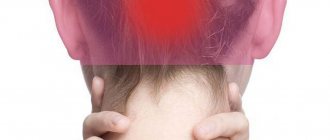A careless attitude towards a common runny nose or cold can provoke the development of sinusitis. Sinusitis is an inflammatory process in the maxillary paranasal sinuses. Another name for them is sinusitis, hence the name of the disease - “sinusitis”.
The maxillary sinuses are located to the right and left of the nose, in the area of the cheeks under the eyes. Healthy, uninflamed sinuses are cavities filled exclusively with air. The mucous membrane of the sinuses secretes the required amount of mucus, which enters the nasal cavity through small openings - anastomoses. But if bacteria are activated in the sinuses, in response to the actions of pathogenic microflora, the mucous membrane of the sinuses swells, the anastomosis closes, and the release of mucous masses becomes impossible. Pus accumulates in the sinus, and severe inflammation starts.
What symptoms does the patient complain of during sinusitis? Why does the disease occur, and what signs of sinusitis should you pay attention to? “Sinusitis: symptoms in adults” is the topic of today’s article.
Reasons for the development of sinusitis
Sinusitis is caused by an infection that gets into the maxillary sinuses. There are cases when bacteria already inhabit the mucous membrane of the human nasopharynx, but their concentration is not enough to negatively affect the body. But as soon as certain factors appear, pathogenic microorganisms turn from a harmless “neighbor” into an enemy: they begin to multiply intensively and carry out their life activities. This is how the inflammatory process starts, sinusitis develops, and the symptoms of the disease make themselves felt.
What factors cause inflammation of the maxillary sinuses?
- infectious diseases of the nasopharynx;
- untreated runny nose;
- poor oral hygiene and dental diseases (for example, caries);
- hypothermia;
- allergic rhinitis;
- deviated nasal septum;
- formations in the nasopharynx (for example, polyps);
- adenoids;
- nasal injuries;
- inhalation of harmful substances (usually in industries);
- weakened immune system;
- tumors of the nasal cavity;
- tuberculosis;
- frequent use of vasoconstrictor nasal drops.
Make an appointment right now!
Call us by phone or use the feedback form
Sign up
It has been scientifically proven that the larger the size of the sinus, the easier it is for pathogenic microflora to get there. The maxillary sinuses are the largest, so they are susceptible to inflammation much more often than other paranasal sinuses.
Pain in the roof of the mouth: main symptoms
As a rule, palate pathologies have characteristic, fairly specific symptoms, which can be used to diagnose the type and complexity of the developing problem:
- The palate of the mouth swells: the surface of the mucous membrane becomes hyperemic, when pressed, elasticity is felt, similar to overgrown tissue;
- Uncomfortable sensations when eating and drinking;
- Redness appears on the upper palate;
- Pain of varying intensity is felt, intensifying upon contact with the tongue;
- Rough palate syndrome appears;
- Discomfort and pain when swallowing, which intensifies when taking hot drinks and food.
If you discover a sore on the roof of your mouth or the above symptoms, you should not start the problem or self-medicate, which can lead to serious complications! Get a high-quality diagnosis, based on the results of which a specialist will prescribe treatment.
Sinusitis: symptoms
In order to recognize the problem in time and contact an ENT doctor, it is important to be able to recognize the signs of sinusitis.
A distinctive sign of sinusitis is headaches and pain in the maxillary sinuses. The patient experiences pain in the cheek area under the eyes. He feels an unpleasant pressure on the bridge of his nose. By evening the pain becomes much stronger. Discomfort in the sinus area also increases when turning or tilting the head. Painful sensations are explained by the presence of pus in the sinuses. The purulent masses become crowded, and they put strong pressure on the walls of the sinuses. With severe inflammation, pain can radiate to the jaw, temples and other parts of the face.
The disease is often accompanied by nasal discharge. At the initial stage they are transparent, but quickly acquire a greenish tint and become viscous. Green snot indicates a bacterial infection in the nasal cavity. There may be no discharge at all if the sinus openings are completely blocked and the mucus and pus cannot come out.
Many patients experience an increase in body temperature to high levels (38.5°).
The patient also has:
- loss or deterioration of sense of smell;
- swelling in the area of the eyelids, eyes, nose;
- nasal voice;
- nasal congestion;
- weakness, fatigue, lack of performance.
These were the general signs. If you have sinusitis, the symptoms will depend on the type of disease.
Sinusitis happens:
- According to the location of inflammation:
- unilateral (right- or left-sided);
- bilateral.
- According to the nature of the flow:
- sharp;
- chronic.
- traumatic;
- allergic;
- odontogenic;
- rhinogenic;
- hematogenous;
- viral;
- bacterial;
- fungal.
- catarrhal;
- exudative;
- purulent;
- polyposis.
There are many classifications of the disease. Let's look at the most common types of sinusitis and the symptoms of these forms.
Acute sinusitis.
The acute form develops very rapidly. They are very intense and knock the patient out of his usual life. Body temperature rises. It happens that it reaches 38-39°C. This is explained by the fact that pathogenic organisms in the sinus begin to actively multiply, and the human body tries to cope with them on its own.
The second characteristic sign of the disease is pain. The cheeks hurt in the sinus area, the bridge of the nose hurts, and pain in the jaw may appear. If the patient tilts or turns his head, sneezes or coughs, the pain intensifies. In the evening this condition worsens.
In some cases, photophobia occurs. Mucus is discharged from the nose. If bacterial flora is raging in the sinus, the discharge is green, which indicates a purulent process.
It becomes very difficult to breathe through the nose, severe congestion occurs. The patient's eyelids swell. The patient feels overwhelmed, lethargic, and cannot carry out his usual activities.
Chronic sinusitis
The chronic form of the disease occurs if the acute form is not fully treated. Chronic inflammation is a sluggishly developing process that lasts more than a month. The symptoms are blurred and clearly manifest themselves only during an exacerbation.
During an exacerbation, the patient complains of the following symptoms:
- low-grade body temperature (up to 37.5°C);
- nasal congestion, which may go away during the day;
- purulent discharge from the nasal cavity;
- pain not only in the bridge of the nose, but also in the jaw area;
- nasal voice;
- weakness, fatigue.
During the period of remission, the disease is more difficult to recognize. Symptoms are not so intense:
- nasal congestion;
- accumulation of mucus in the throat, which drains from the nasopharynx;
- headache;
- swelling of the eyelids in the morning after sleep;
- impaired sense of smell.
Traumatic sinusitis
The cause of the development of this form of the disease is severe trauma to the skull, which is often accompanied by damage to the nasal septum. Due to heavy bleeding, blood clots can get into the maxillary sinuses. If the problem is not identified in a timely manner, an infection may develop and suppuration may develop. Polyps and growths can form in a sinus that is inflamed after an injury.
The patient's body temperature rises and headaches appear. The inflammatory process can spread to neighboring tissues, causing the formation of phlegmon or abscess (suppuration). Treatment of this form is carried out inpatiently.
With chronic inflammation, a person complains of pain in the sinuses, congestion, and nasal discharge. Swelling of the eyelids and swelling of the cheek on the side of the affected sinus may be observed. A fistula (fistula) may form in the infraorbital region with pus discharged from there. Patients with this diagnosis undergo sinus surgery to remove fistulas and polyps.
Friends! Timely and correct treatment will ensure you a speedy recovery!
Allergic sinusitis
The cause of the allergic form of the disease is contact of the sinus mucosa with an allergen (an irritating substance).
The disease resembles a manifestation of classic allergies. The main features of this form are:
- persistent cough that does not go away even after taking antitussive medications;
- impaired nasal breathing;
- nasal congestion;
- mucus from the nose;
- bouts of sneezing;
- swelling;
- itching in the eyes.
Irritating substances can be dust, animal hair, pollen, cosmetics, etc. It is necessary to identify the allergen as quickly as possible and eliminate its effect on the body.
Odontogenic sinusitis
Infection in the sinus can come not only from the nasopharynx. In the odontogenic form, pathogenic microflora penetrates the sinus from the roots of the teeth of the upper jaw. The disease can occur in acute and chronic forms with symptoms characteristic of these types of inflammation. In the case of odontogenic sinusitis, therapy by an ENT doctor alone is not enough. It is necessary to contact a dentist and deal with the “problem” teeth - treat them or remove them.
Catarrhal sinusitis
The catarrhal form is characterized by inflammation and swelling of the sinus mucosa. The patient has:
- weakness, deterioration of health;
- runny nose;
- nasal congestion;
- slight increase in body temperature (sometimes there is no temperature).
This is the initial stage of inflammation. If it was not possible to diagnose the disease during this period, the catarrhal form easily turns into a purulent form. At this stage, few patients turn to an otolaryngologist, since the disease resembles a cold, and many begin to treat themselves, wasting time.
Exudative sinusitis
With this form, exudate (inflammatory fluid) forms and accumulates in the sinuses. The main symptoms of the disease are:
- pain in the sinuses, headaches that get worse when moving the head;
- thick nasal discharge;
- nasal congestion;
- temperature increase;
- problems with smell;
- deterioration of health.
To prevent the disease from passing into a purulent stage and complications arising, you need to contact an ENT specialist immediately when the first signs of inflammation appear.
Purulent sinusitis
The purulent form of the disease develops when a bacterial infection joins the inflammation. Pus accumulates in the sinuses and cannot come out.
The patient is concerned about the following symptoms:
- high body temperature;
- sinus pain and headaches become very intense;
- loss of smell;
- nasal discharge with an unpleasant odor.
This is a dangerous form of the disease. After all, any concentration of pus near the brain can lead to serious consequences, including death.
Polypous sinusitis
In the polypous form of the disease, changes occur in the mucous membrane of the sinuses. It grows and polyps form, which increase in size and “descend” into the nasal passages. Because of this, the patient begins to have problems with nasal breathing, and he begins to breathe mainly through the mouth. In this case, surgical removal of polyps brings a positive result.
Features of the clinical picture
The longer the inflammation, the more pronounced the headache will be, but it will not have a clear localization and usually occurs periodically throughout the day. Often its intensity depends on the position of the body, for example, it decreases at rest and increases with bending and moving the head, tension, or a tight collar of clothing.
Painful sensations during inflammation in the paranasal sinuses have their own characteristics:
- increasing tactile sensitivity of facial skin;
- there is a feeling of fullness in the area of localization of the pathological process; when pressing on the area of the bridge of the nose, the wings of the nose, acute pain occurs;
- discomfort increases when the temperature changes (for example, when leaving a warm room into the cold);
- more pronounced in the morning, immediately after waking up, especially if during the night's rest in the bedroom the parameters of humidity and air temperature are not observed;
- manifest against the background or after suffering from acute respiratory viral infection.
Most respiratory viral infections (with the exception of influenza, COVID-19 and some others) are characterized by rhinorrhea, caused by inflammation in the mucous membrane of the nasal cavity and increased vascular permeability. Normally, the acute phase of rhinitis lasts about 1–3 days, after which noticeable relief is felt. However, in some cases, a common runny nose develops into sinusitis, and one of its first symptoms is an unpleasant persistent headache.
Complications of sinusitis
Inflammation of the maxillary sinuses is not a common cold. Lack of proper therapy can cause serious complications. In particularly severe cases, the disease can be fatal.
What complications can improper treatment lead to?
- Transition from acute to chronic inflammation.
- Inflammation of the respiratory tract (tonsillitis, bronchitis, pneumonia, etc.)
- Osteomyelitis, when an infection from the sinuses affects the bone tissue.
- Meningitis is an inflammation of the lining of the brain.
- Sepsis.
The last two conditions can be fatal. Therefore, you need to be treated immediately and only under the supervision of an ENT doctor.
Causes of pain in the forehead
The most common causes of forehead pain:
- Head injury;
- Head injuries;
- Sun or heatstroke;
- Concussion;
- Infectious, inflammatory disease (frontal sinusitis, sinusitis), respiratory diseases, influenza, meningitis;
- Increased intracranial pressure;
- Cardiovascular diseases;
- Vegetative-vascular dystonia;
- Neurological diseases;
- Constant overexertion and stress;
- Tumor diseases of the brain.
The most common cause of pain in the forehead area is infectious diseases, such as sinusitis, rhinitis, and sinusitis.
Sinusitis: treatment
Treatment tactics are selected individually, based on the form of the disease and the patient’s condition. At the initial appointment, the otolaryngologist carries out diagnostic measures to confirm the presence of inflammation. For this purpose, rhinoscopy, endoscopy of the nasal cavity, and sinus scanning are performed. If necessary, the patient is sent for an x-ray. An x-ray allows the ENT doctor to draw the necessary conclusions about the condition of the sinuses.
The general treatment regimen includes:
- antibacterial drugs (the drug and dosage are prescribed exclusively by an otolaryngologist. It is important to take the full course of the medicine, even if you feel relief. An untreated disease easily becomes chronic or provokes serious complications);
- antihistamines to relieve swelling of the mucous membrane of the sinuses and nasal cavity;
- rinsing the nose with saline solutions;
- vasoconstrictor drops;
- antiseptics;
- antipyretic drugs.
An important stage of treatment is the rinsing of the maxillary sinuses by an ENT doctor, which allows the sinuses to be cleared of pathogenic contents. There are two methods of washing: vacuum by moving liquid (patients are more familiar with the common name for the procedure - “cuckoo”) and washing with a YAMIK catheter.
It is important not only to thoroughly rinse the sinuses, but also to stop inflammation. Physiotherapeutic procedures do an excellent job of this task, which also improve tissue trophism and enhance the effect of medications:
- infrared laser therapy;
- vibroacoustic therapy;
- ultraviolet irradiation;
- photodynamic therapy;
- magnetotherapy.
If the patient’s condition is severe, and no methods help clear the sinuses of pus, the ENT doctor performs a sinus puncture (puncture), combining it with medication and physiotherapy.
Principles of treatment of headaches due to sinusitis
The most important point of therapy is the elimination of congestion, the main cause of pain. For treatment use:
- vasoconstrictor drops: indicated in the acute period, the duration of treatment with one drug (we are not talking about the trade name, but about the active substance) should not exceed 4-5 days, after which an analogue is prescribed or the drug is discontinued;
- non-steroidal anti-inflammatory drugs, which simultaneously have analgesic properties;
- nasal sprays containing corticosteroids: help reduce the intensity of the inflammatory reaction;
- enzymes and mucolytics that dilute the contents of the paranasal sinuses and facilitate the passage of mucus;
- antihistamines that help reduce swelling (prescribed for a short time, for the symptomatic treatment of headaches due to sinusitis);
- antibiotics (used either topically, in the form of sprays, or systemically in tablet form when a bacterial infection is confirmed), antifungal, antiviral agents;
- antimicrobial drugs containing silver ions;
- herbal remedies based on eucalyptus, menthol, etc.
In severe cases of the disease, physiotherapy is indicated for the treatment of headaches due to sinusitis. If the desired effect from conservative therapy is absent, a puncture is suggested - puncture of the paranasal sinus, cleansing it of purulent contents and rinsing with disinfectant solutions.
Sinusitis headaches tend to be recurrent and chronic. Therefore, not only treatment, but also prevention is important. To reduce the drug load on the body, you need to monitor the parameters of the air temperature in the room, humidity, and remove all “dust collectors” from the house (stuffed toys, carpets, various trinkets, etc.). If we are talking about frequent sinusitis at an early age, doctors recommend thinking about removing the adenoids.
The text was checked by expert doctors: Head of the socio-psychological service of the Alkoklinik MC, psychologist Yu.P. Baranova, L.A. Serova, a psychiatrist-narcologist.
CAN'T FIND THE ANSWER?
Consult a specialist
Or call: +7 (495) 798-30-80
Call! We work around the clock!
The roof of the mouth hurts: causes and treatment in dental clinics
The services of highly qualified specialists are an opportunity to eliminate the problem quickly and safely for health. Already at the first appointment, the doctor conducts a comprehensive examination and diagnoses the problem. This approach allows us to determine the exact cause of the development of symptoms, as well as prescribe adequate treatment, taking into account the individual characteristics of the patient.
Are you experiencing discomfort and want to treat an inflamed palate in your mouth? Contact the specialized dental clinic "Alpha Dent" in Orenburg! Our specialists will conduct a comprehensive diagnosis, determine the cause of the problem and prescribe adequate treatment!









